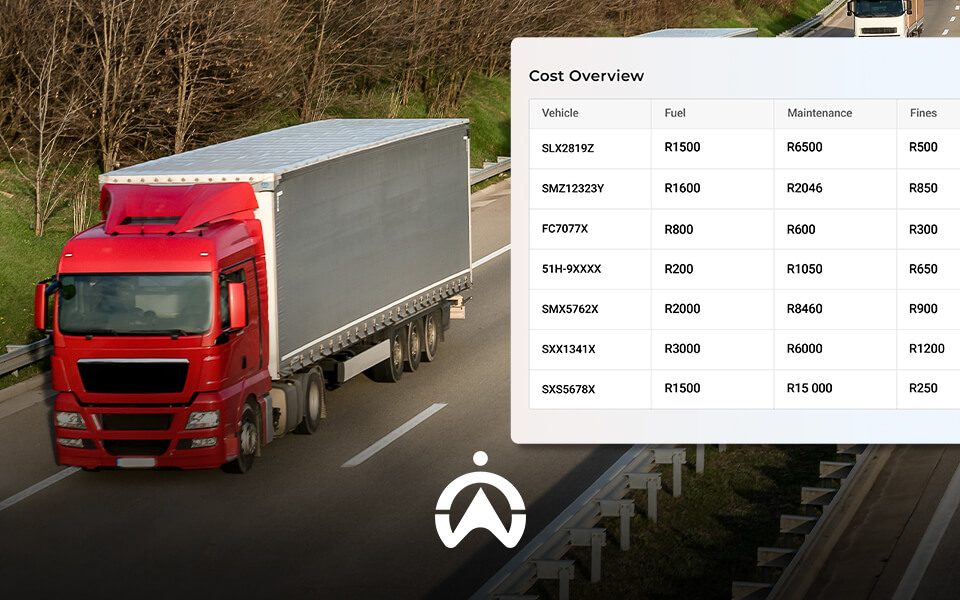Are You on Top of Your Fleet Management Standard Operating Procedures? – What You Need to Know
Fleet Standard Operating Procedures (SOPs) are your secret recipe for running a safe, compliant and efficient fleet.
Fleet SOPs usually include guidelines for vehicle maintenance, driver safety, fuel management and more. Although these guidelines are essential for all stakeholders, unfortunately, many businesses keep this powerful tool locked away in a cupboard, rendering it almost useless.
SOPs are only effective if your stakeholders engage with them daily, so join us and discover how to get on top of your fleet SOPs using fleet management software.
In this article, you will:
-
Learn about fleet management standard operating procedures (SOPs).
-
Discover the top benefits of fleet SOPs.
-
Assess whether your fleet is reaping the benefits of your SOPs.
-
Learn how to create and implement standard operating procedures for your fleet.
-
Uncover 7 Cartrack Namibia software features that help businesses develop effective fleet SOPs.
What are fleet management standard operating procedures (SOPs)
The topmost challenging aspects for fleet managers include driver engagement and safety, leadership support, and regulatory compliance. Fleet management standard operating procedures (SOPs) are the perfect guide to help fleet managers handle challenges like this and more.
Fleet SOPs are important for risk management and ensuring everyone in your fleet remains responsible and accountable. They help ensure that anyone who uses your fleet knows the correct way to request and operate your vehicles/equipment.
Most SOPs for fleet management will include the following guidelines:
- Vehicle asset verification
- Acquiring, replacing and disposing of vehicles
- Applications for vehicle use
- Vehicle and equipment safety
- Vehicle repairs and maintenance
- Driver safety and regulatory compliance
- Fuel management
- Cost management
- Accident/incident reporting
Fleet management procedures are not only necessary for driver and fleet safety; they are a strategic way of safeguarding your business. Effective SOPs show your commitment to fleet safety and compliance, which is assuring for all stakeholders.
The 5 top benefits of Fleet Management SOPs
Fleet management SOPs cover managing your fleet well and getting the best Return on Investment. Do you currently achieve the following benefits from your fleet SOPs?
#1 Improved fleet safety
SOPs help businesses, fleet managers, and drivers prioritise safety in their fleet. With measures that encourage driver safety training, vehicle maintenance, and pre-trip inspection, fleet managers can effectively improve their overall fleet safety using SOPs.
#2 Increasing fleet efficiency
By setting SOPs for vehicle usage, fuel management, and cost monitoring, fleet managers contribute to increased fleet efficiency. These measures help extend your vehicle’s lifespan, reduce costs and improve fuel efficiency. Your SOPs should contribute to you reaping the return on your investment and assets.
#3 Enhancing fleet compliance
Outdated SOPs can lead to compliance issues and unexpected fines. SOPs ensure a compliant fleet by outlining the processes for maintaining records, updating information, and paying regulatory fines. Fleet SOPs should be current and up to date to help you maintain a compliant fleet—are yours?
#4 Improved communication between managers, drivers, and stakeholders
SOPs provide clear guidelines for all stakeholders, enabling managers and drivers to understand their roles and responsibilities. With fleet SOPs, setting measures to increase communication and remote management helps businesses improve their overall operations.
#5 Reduced fleet costs
Having SOPs for your fleet ultimately helps reduce costs and increase profitability. With measures on how to claim back for fuel, timesheets, and how to calculate vehicle operating hours, businesses avoid financial losses and identify costly profit drainages.
If your fleet’s SOPs don’t help you attain one or more of these benefits, then it’s time to upgrade them.
Here’s a quick guide to get started on upgrading your SOPs.

How to create and implement fleet management SOPs
This step-by-step guide describes three important parts in the process of building SOPs and finally putting them into practice for your fleet. If you already have SOPs for your fleet, these steps will help you improve them and ensure they are still relevant for your fleet and business.
First things first: Identify fleet challenges
Begin by identifying key fleet management challenges where Standard Operating Procedures (SOPs) can be beneficial. For example, is your fleet experiencing a profitability downturn? Perhaps your drivers are frequently missing deliveries or your fleet vehicles keep ending up in the repair shop. Identifying these challenges can help you move on to a viable solution.
Incorporating standard operating procedures into your workforce and task management would lead to better asset utilisation and increased profitability.
Here are 15 fleet-related challenges that SOPs could help with:
- High fleet downtime
- Poor communication between managers and drivers
- Redundant vehicles
- Driver identification for vehicles
- Operator identification for equipment
- Violations and fines against your fleet
- Overbilling for repairs, maintenance, or service
- Penalties for non-compliance
- Poor driver behaviour and performance
- Lack of vehicle/equipment maintenance
- Increased vehicle wear and tear
- Poor administration
- Out-of-hand fuel costs
- Suspected fuel theft
- Safety issues
Unfortunately, a one-size-fits-all approach to SOPs is not ideal. The list of fleet management challenges is endless, so identifying your fleet-specific challenges is the only way to develop effective SOPs. Don’t worry, though, once you start implementing these, you’ll start reaping the rewards.
Next: Involve relevant stakeholders
When developing your fleet SOPs, include fleet managers, drivers, mechanics, field service workers and even someone from your legal department (if applicable) in the process.
By making this process a group effort, you can ensure that everyone is aware of the SOPs and understands:
- What the SOPs aim to achieve
- Who the SOPs apply to and under which circumstances they must be used
- Who is responsible for specific tasks
- Who is accountable for whether the SOPs are implemented correctly
- The specific procedures to be followed
Take fleet safety for instance; here’s how involving stakeholders in developing SOPs can help.
In a recent survey about today’s fleet managers’ priorities, only 50% of fleet managers surveyed said they believe their company continuously strives to improve their employee safety. In the same survey, however, 22% said their company mainly focuses on solutions that improve the bottom line/profitability.
This survey shows the importance of prioritising leadership, businesses, and stakeholders. Businesses need to show that they are focused on solutions to improve profitability, without compromising driver safety.
Involving all relevant stakeholders also shows that your business equally values both profitability and safety.
In the process of developing SOPs, aim to at least involve:
- Fleet managers
- Drivers
- Health and safety experts
- Trainers
These stakeholders are priceless to your business and process because of their industry expertise and understanding of your unique fleet challenges.
Time to develop and share: Share SOPs with all stakeholders
While this part of SOPs development may require a bit of effort, there are plenty of experts who advise on how to write procedures for your fleet, helping you simplify the process.
Our advice is simple when it comes to your fleet: You should at least have or regularly update SOPs for these six fleet management areas:
- Fuel management
- Vehicle maintenance and repairs
- Fleet cost management
- Fleet compliance
- Vehicle usage and management
- Driver training and safety
- Reporting accidents and liability
- Health and safety
- Driver management
Ensure your procedures are easy to understand and explained to all stakeholders. You may want to consider offering training on your SOPs to all the relevant people. According to the J.J. Keller Center for Market Insights, over 52% of fleet managers surveyed believe it’s important that their drivers apply what they learn in training and that the training is specific to their unique needs. By training drivers on your fleet SOPs, you can be assured that your drivers engage your SOPs.
After developing your fleet SOPs, remember to make them easily and readily accessible to everyone. You should also update them frequently, so consider getting a user-friendly platform to access your SOPs and update them from anywhere.
Now that we’ve given you a guide to building SOPs, you’ll need to know how fleet management software like Cartrack’s can help you develop your fleet’s standard operating procedures.

7 Cartrack fleet software features to develop your fleet (SOPs)
Cartrack’s fleet management software helps businesses develop and establish fleet manager and driver engagement with fleet SOPs.
These seven features assist with complete fleet management:
Feature 1: GPS for fleet tracking
Our GPS tracking system lets fleet managers track and pin their fleet’s live location anytime and anywhere, unlocking the ultimate fleet visibility and management. This information helps fleet managers know exactly where their drivers and fleet are located to monitor driver performance and productivity, communicate instructions with drivers, or immediately respond in an emergency.
Feature 2: Digital fleet reports and records
Using our GPS tracking and other smart tools, fleet managers can create customised automated reports to get data on vehicle performance, fuel consumption, and fleet-related costs. MiFleet is our advanced cost management software that simplifies fleet cost administration, helping you get an overview of your fleet, identify financial leakages, and perform a bulletproof cost analysis.
Our web-based software allows approved stakeholders to easily access vehicle, driver, and cost-related reports from anywhere. The fleet reports are designed to assist fleet managers in making data-driven decisions about their fleet.
Feature 3: Preventative maintenance
Cartrack’s telematics-based solution also gives valuable insights into vehicle conditions. Fleet managers receive notifications on vehicle problems such as engine faults and battery failures as proactive reminders to service their vehicles or schedule maintenance. With the added benefit of uploading invoices for accurate record-keeping, fleet managers have everything they need in one place to ensure optimal fleet performance and reduced downtime.
Feature 4: Driver monitoring
Our fleet and worker management solutions include GPS tracking, driver identification tools, driver behaviour reports, and AI camera systems to monitor driver productivity and performance. Fleet managers can monitor and track different driver behaviours in real time, staying on top of irresponsible driving behaviour like speeding, idling, and harsh braking. If you’re struggling with fleet safety issues, Cartrack’s driver monitoring solutions help you identify and address unproductive driving habits.
By integrating Cartrack’s SmartCabin camera solutions, fleet managers can also get live audio and visual recordings to help train drivers on dangerous driving. Cameras are also useful for liability problems in the event of an accident. Our driver monitoring solutions help fleet businesses improve fleet productivity and safety.
Feature 5: Fuel management system
Our comprehensive fuel management system is equipped with fuel monitoring sensors, vehicle tracking, and fuel cost management, helping businesses to accurately track and cut fuel inefficiencies. Managers receive notifications for suspected fuel theft and can customise fuel reports to understand not only risks like theft or fraud but also their fleet’s overall consumption. SOPs ultimately help fleet managers establish solid fuel claim validation procedures to help clamp down on fraudulent activities and increase their fuel budget flexibility.
Features 6: Fleet compliance (insurance, taxes, fines, and toll payments)
Cartrack’s MiFleet also helps fleet managers ensure their fleet complies with industry-specific and standard regulations. Fleet managers can upload information and set expiration dates and reminders for vehicle insurance, road tax certificates, and toll card payments, helping avoid late payment penalties and fines.
Feature 7: Cartrack Namibia website and app for instant communication
With online access and a user-friendly app, our fleet management system supports uninterrupted, clear communication between fleet managers and drivers. Fleet managers can use both the app and website to assign tasks, check task progress, and communicate with their drivers for optimised productivity in industries like delivery, logistics, supply chain, and mining.
Perfect your SOPs and supercharge your fleet profits with Cartrack Namibia
Your fleet’s standard operating procedures are important and invaluable to your business. They safeguard your fleet managers, drivers, fleet, and overall business.
Our fleet management software helps you ensure everyone involved engages with the SOPs to improve productivity, safety, and compliance.



